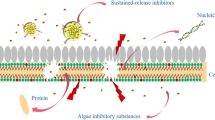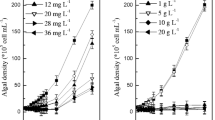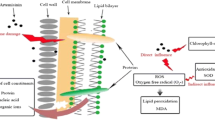Abstract
A new artemisinin sustained-release particle (ASP) was developed that significantly inhibits Microcystis aeruginosa (M. aeruginosa) growth. The physical and chemical properties of ASPs were characterized using scanning electron microscopy (SEM), Fourier transform infrared spectroscopy (FT-IR), X-ray diffraction (XRD), differential scanning calorimetry, and thermogravimetry (DSC-TG). The results demonstrated that ASPs are thermally stable and have sustained-release properties. On the sixth day, the ASPs (0.2 g L−1) inhibited M. aeruginosa with an inhibition rate (IR) greater than 70%. Additionally, ASPs inhibited M. aeruginosa without increasing microcystin-LR release (MC-LR). This research offers a novel approach to the management of cyanobacterial blooms.





Similar content being viewed by others
References
Camean A et al (2005) Pyrolytic behaviour of microcystins and microcystin-spiked algal blooms. J Anal Appl Pyrolysis 74 (1–2):19–25
Carmichael W (2008) Chap. 4: a world overview—one-hundred-twenty-seven years of research on toxic cyanobacteria—where do we go from here? In: Hudnell HK (ed) Cyanobacterial Harmful Algal Blooms: state of the Science and Research needs. Springer, Berlin, pp 105–125
Chakraborty S et al (2022) Irregular harmful algal blooms triggered by feedback between toxin production and zooplankton feeding. Ecol Model 473:110120
Chen F et al (2012) Preparation and characterization of oxidized alginate covalently cross-linked galactosylated chitosan scaffold for liver tissue engineering. Mater Sci Eng C 32 (2):310–320
Doblin MA et al (2007) Dynamics and short-term survival of toxic cyanobacteria species in ballast water from NOBOB vessels transiting the Great Lakes - implications for HAB invasions. Harmful Algae 6 (4):519–530
Fengmin LI et al (2007) Influence of EMA isolated from Phragmites communis on physiological characters of Microcystis aeruginosa. China Environ Sci 27 (3):377–381
Finaurini S et al (2012) Dihydroartemisinin inhibits the human erythroid cell differentiation by altering the cell cycle. Toxicology 300 (1):57–66
Han X et al (2022) Preparation, characterization and antibacterial activity of new ionized chitosan. Carbohydr Polym 290:119490
Istvánovics V (2009) Eutrophication of lakes and reservoirs. In: Likens GE (ed) Encyclopedia of inland waters. Academic Press, Oxford, pp 157–165
Jessing KK et al (2014) Temperature-dependent toxicity of Artemisinin toward the Macrophyte Lemna minor and the Algae Pseudokirchneriella subcapitata. Water Air Soil Pollut 225 (6):12
Liu ZQ et al (2013) The interaction between nitrobenzene and Microcystis aeruginosa and its potential to impact water quality. Chemosphere 92 (9):1201–1206
Lv LP et al (2018) Flocculation of low algae concentration water using polydiallyldimethylammonium chloride coupled with polysilicate aluminum ferrite. Environ Technol 39 (1):83–90
Lyck S (2004) Simultaneous changes in cell quotas of microcystin, chlorophyll a, protein and carbohydrate during different growth phases of a batch culture experiment with Microcystis aeruginosa. J Plankton Res 26 (7):727–736
Moles P et al (2008) A theoretical study on the decomposition mechanism of artemisinin. Tetrahedron 64 (40):9448–9463
Ni L et al (2012) Isolation and identification of an anti-algal compound from Artemisia annua and mechanisms of inhibitory effect on algae. Chemosphere 88 (9):1051–1057
Ni L et al (2013) Preparation and characterization of anti-algal sustained-release granules and their inhibitory effects on algae. Chemosphere 91 (5):608–615
Ni L et al (2018) Inhibitory effect and mechanism of linoleic acid sustained-release microspheres on Microcystis aeruginosa at different growth phases. Chemosphere 212:654–661
Oberholster PJ et al (2003) Microcystis aeruginosa: source of toxic microcystins in drinking water. Afr J Biotechnol 3 (3):159–168
Pham T-L et al (2018) An overview of the accumulation of microcystins in aquatic ecosystems. J Environ Manage 213:520–529
Tran QN et al (2022) Enhanced removal of extracellular microcystin-LR using chitosan coagulation-ultrafiltration: performance and mechanisms. J Environ Chem Eng 10 (3):107902
Wood SA et al (2012) Increasing Microcystis cell density enhances microcystin synthesis: a mesocosm study. Inland Waters 2 (1):17–22
Zhou Q et al (2014) Impacts of Eichhornia crassipes (Mart.) Solms stress on the physiological characteristics, microcystin production and release of Microcystis aeruginosa. Biochem Syst Ecol 55:148–155
Zimba PV et al (2001) Confirmation of catfish, Ictalurus punctatus (Rafinesque), mortality from Microcystis toxins. J Fish Dis 24 (1):41–47
Acknowledgement
This work was supported jointly by the Key Program of the National Natural Science Foundation of China (Grant Nos. 51779079, 51979137), the Innovative Research Group Project of the National Natural Science Foundation of China (Grant No. 51421006), the Program for Changjiang Scholars and Innovative Research Team at Hohai University (Grant No. IRT13061), the Natural Science Foundation of Jiangsu Province (Grant No. BK20181313).
Author information
Authors and Affiliations
Corresponding author
Additional information
Publisher’s Note
Springer Nature remains neutral with regard to jurisdictional claims in published maps and institutional affiliations.
Rights and permissions
Springer Nature or its licensor (e.g. a society or other partner) holds exclusive rights to this article under a publishing agreement with the author(s) or other rightsholder(s); author self-archiving of the accepted manuscript version of this article is solely governed by the terms of such publishing agreement and applicable law.
About this article
Cite this article
Ni, L., Zhu, C., Du, C. et al. Characterization of a Novel Artemisinin Algicidal Particle and Its Inhibitory Effect on Microcystis aeruginosa. Bull Environ Contam Toxicol 110, 82 (2023). https://doi.org/10.1007/s00128-023-03718-4
Received:
Accepted:
Published:
DOI: https://doi.org/10.1007/s00128-023-03718-4




